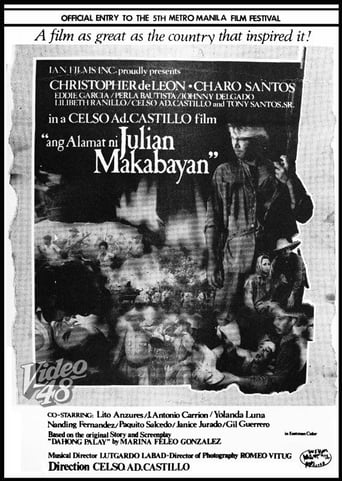janjalana
This movie, although titled "alamat" (legend), really points to a real-life peasant leader named Julian, as told by the old folks of a town in Nueva Ecija (a Philippine province). Identifying the time period is a little tricky. It may be be a Spanish-era movie, based on the powers of the local priest, but it can also be set in the 1930s or 50s. Only Charo Santos' costumes give the viewers a vague idea as to when the story takes place. I'm thinking if this movie was released in 1979, and one of the old women interviewed was a contemporary of Julian, then his story must have taken place in the 1920s to the 1940s, before World War II.This is one of the earlier Filipino films to tackle peasant oppression in the Philippines, as well as the freedom of assembly, involuntary servitude, sexually repressed and thus obsessed Catholic priests, and the seemingly endless cycle of poverty and dehumanization. It starts with a scene in a village wedding reception, with the bride getting ready for the church rites. They get to the church by boarding a cart drawn by a water buffalo. In the wedding ceremony, the town priest warns Julian (the elder Julian..this is a little confusing at the start as to who the title is speaking of...)about joining peasant groups. Shortly after the wedding, the elder Julian is captured by the local police force, allegedly for joining a rebellion. His wife goes to the parish priest (played by Eddie Garcia), who seems to have a hand in everything that happens in the town, and asks that her husband be freed. The priest assents, but not before getting something in exchange for the young bride's favor. Afterwards, the movie gets moving with young Julian growing up, witnessing the oppression of his peasant class in the hands of the local powers-that-be, landlords and politicians. In an almost all-too-worn-out theme he falls in love with the daughter (played by Charo Santos) ofna member of the local elite. A highlight of the movie is when Maria, the sweetheart of his best friend (played by young Johnny Delgado) is forced into domestic servitude, due to an unpaid debt by her grandfather to a local landlord. Julian and his friend goes to the priest, and asks him to absolve the family of the debt, saying "I ask this of you, not as a priest, but as my father." The film uses musical scoring effectively, and one of the most memorable scenes in when his best friend's father dies in an clash between the peasants and the police. The casket is refused entry into the church. Later in the movie, the same thing happens with Julian senior's casket. Julian junior engages in a staring contest with the priest, and wins.The subtitles are fair enough, even without the benefit of modern technology (you can see the edges of the transparent material where they printed the subs) but the translation doesn't seem to capture most of the mood and tone in the Tagalog dialog, the way it does in "Tinimbang Ka Ngunit Kulang."All in all, if you liked other Tagalog classics such as "Itim", "Tinimbang Ka Ngunit Kulang", "Ganito Kami Noon, Paano Na Kami Ngayon?" you definitely should try this film.

